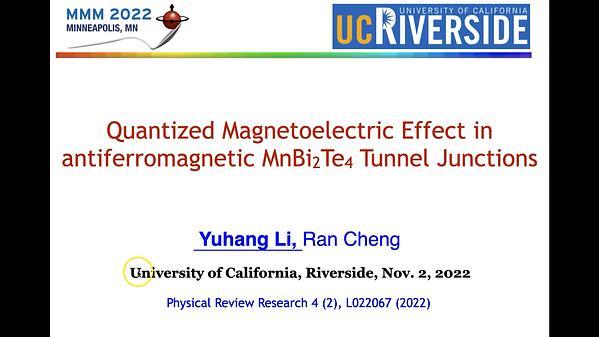Would you like to see your presentation here, made available to a global audience of researchers?
Add your own presentation or have us affordably record your next conference.
A type-II Weyl semimetal, WTe2 is receiving great attention in spin physics because of the generation of spin polarization due to fictitious Weyl monopoles. In a previous study, in-plane spin polarization (Sy, parallel to the b-axis of WTe2) originating from the Weyl node was reported by introducing an electrical method even though detection is limited at very low temperature 1. Meanwhile, the existence of spin polarization along the c-axis (Sz, perpendicular to the plane) in WTe2 was suggested by using angle-resolved photoemission spectroscopy (ARPES) 2, and Sz spin polarization can affect the spin-torque ferromagnetic resonance (ST-FMR) of adjacent ferromagnets 3. However, the Sz spin generation using an electrical method, which is suitable for investigation of more precise origin of Sz spin polarization, has not been explored.
In this study, we successfully detected the Sz spin polarization of Td-type WTe2 using an all-electric method that is an expansion of the experimental technique for detecting topological surface spin polarization in BiSbTeSe 4. Perpendicular magnetic anisotropy (PMA) electrodes made of Pt/Co10 (“10” denotes a stacking number) and nonmagnetic Pt electrodes were deposited on the mechanically exfoliated WTe2, and the out-of-plane magnetic field dependence of spin voltages was measured from 5 K to 300 K (see Fig.1). Figure 2 shows the result at 5 K and 300 K, and the hysteresis attributed to spin accumulation beneath the PMA electrode was successfully observed up to 300 K 5. In addition, the polarity of spin voltage hysteresis was reversed by switching the electric current direction, and the hysteresis vanished when the direction of current changes to parallel to the b-axis of WTe2. These evidence that the Sz spin polarization was originating from the in-plane symmetry breaking of WTe2. Other supporting evidence and detailed discussion will be given in the presentation.
References 1 P. Li et al., Nat. Commun. 9, 3990 (2018).
2 P.K. Das et al., Nat. Commun. 7, 10847 (2016).
3 D. MacNeil et al., Nat. Phys. 13, 300-306 (2017).
4 Y. Ando, M. Shiraishi et al., Nano Lett. 14, 6226 (2014).
5 K. Ohnishi, Y. Ando, M. Shiraishi et al., under review.

